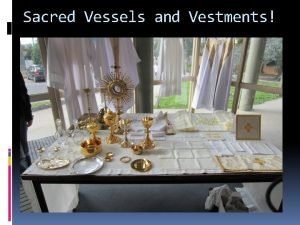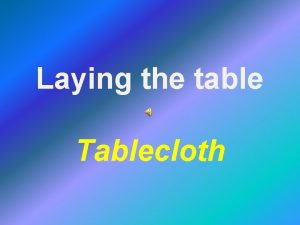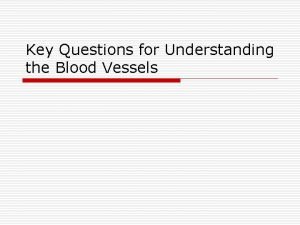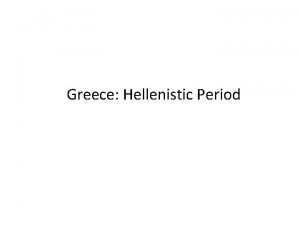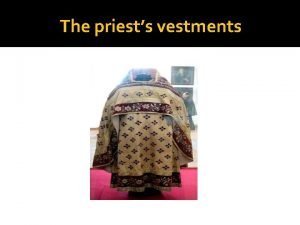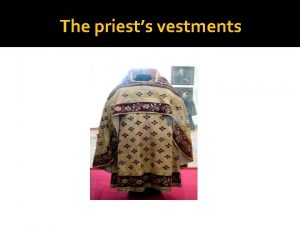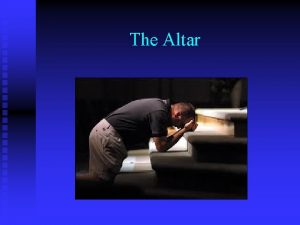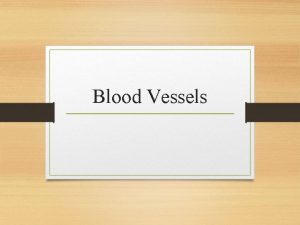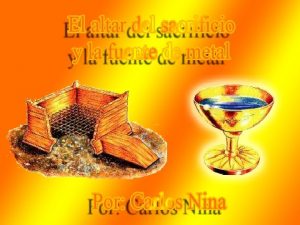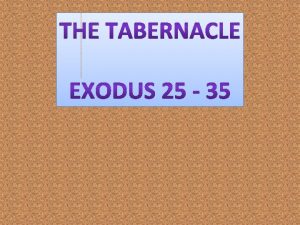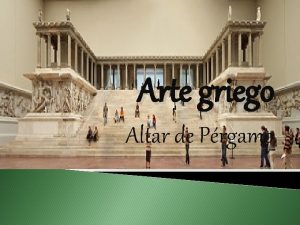THE ALTAR VESTMENTS LINENS AND VESSELS USED AT

















- Slides: 17

THE ALTAR VESTMENTS LINENS AND VESSELS USED AT MASS AND WHAT THEY REPRESENT PLEASE TURN ON YOUR SPEAKERS www. jeevanjal. org

Holy Sacrifice of the mass is Jesus’ passion and death at Calvary brought to us on the altar everyday. In the place of the priest who is offering the sacrifice is Jesus Himself offering His Life as a sacrifice to the Father for you and for me. The altar is Calvary and the priest is clothed exactly as Jesus was clothed in His passion. The following presentation explains.

A consecrated altar, which must in every Church or Chapel occupy an elevated position, because it represents the Mount Calvary whereon Christ, the guiltless victim, was killed in the sacrifice and lifted up on the Cross.

The Amice, which the priest passes over his head and places around his neck; this represents the linen cloth with which in the house of Caiphas the Jews covered Christ’s countenance, bidding Him in mockery: “Prophecy to us, who is it that struck Thee” A short, oblong vestment of white linen worn beneath the alb to cover the shoulders of the priest while celebrating Mass. This piece of vestment is no more used in many parts of the world today. When putting on the amice, the priest says, “Put on my head, O Lord, the helmet of salvation in order to repel the assaults of the devil. ”

The alb symbolizes the garment in which Christ was clothed by Herod and the purity of the soul with which the Sacrifice of the Mass should be offered. “Make me white O Lord and cleanse my heart that, made white by the Blood of the Lamb, I may be able to serve Thee” is said by the priest as he puts on the alb. An alb is a plain, lightweight, anklelength tunic with long sleeves. It is generally worn with a girdle. The word alb is short for the Latin phrase tunica alba, which means white tunic

The linen girdle, with which the priest girds himself, and which represents the cord that bound Our Lord to the pillar when He was being scourged. A girdle is anything worn around the waist to gather or hold up clothing. It symbolizes modesty, and also readiness for hard work in God’s service. “Gird me, O Lord, with the cincture of purity and extinguish in my heart the fire of the desires of the world so that the virtue of yielding to impulse and chastity always abiding in my heart, I may better serve Thee. ”

The Maniple, which is placed on the priest’s left arm, represents the bonds wherewith Christ’s hands were tied. This piece of vestment is no more used in many parts of the world today. “May I deserve, O Lord, to carry this maniple of sorrow and penance so that I may one day enjoy the reward of all my labors. ”

The Stole, which placed around the neck of the priest and crossed upon his breast, represents the chains laid upon our Lord after He was sentenced to death. A Stole is a liturgical vestment composed of a strip of material from two to four inches wide and about eighty inches long. It has either a uniform width throughout, or is somewhat narrower towards the middle, widening at the ends and is worn around the neck so that it hangs down in front of the wearer’s legs, ending below the knees. A small cross is generally sewed or embroidered on the stole at both ends and in the middle; the cross, however, is prescribed only for the middle, where the priest kisses the stole before putting it on. There are no express precepts concerning the material of the stole, but silk, or at least a half-silk fabric, is most appropriate. “O Lord, Who hast said, ‘My yoke is sweet and My burden is light, ’ grant that I may so carry it as to merit Thy grace. ”

The Chasuble, which represents the purple robe wherewith the impious soldiers clothed Him in mockery at the crowning with thorns; the cross upon the chasuble represents the Cross to which Christ was nailed; the pillar; the column at which He was scourged. A chasuble is a decorated circular garment with a hole in the center for the wearer’s head. When worn, it reaches to the wearer’s wrists, so that if the wearer holds both arms straight out, the chasuble forms a semi-circle when viewed from the front or the back.

Colours of the Chasuble and their significance White: The symbol of innocence and triumph. It signifies the joy and purity of the soul. The white vestment is the peaceable garment used on all the feasts of the joyful and glorious mysteries of our Lord’s life, on the feasts of our Blessed Mother, on the feasts of angels and of all saints who were not martyrs. It is also worn from Christmas to the Epiphany, and during Eastertide. Red: The color of blood, is used on all feasts of our Lord’s Cross and Passion, on the feasts of the Apostles and of all martyrs. Red is also used on Pentecost and in Masses of the Holy Spirit, in memory of the tongues of fire of the First Pentecost. Red also signifies the fire of love towards God. Green: The color of budding and living vegetation, of hope. It is used on the Sundays after Epiphany and after Pentecost. Purple: The color of humility and penance is worn in times of repentance. It is used during the penitential seasons of Advent, Septuagesima and Lent, and on fast days and vigils.

A Consecrated Chalice, which represents the grave wherein the Lord was laid, or the bitter chalice of His Passion that He drank to the last drop.

The Pall is a stiff white linen to cover the chalice; this represents the stone that closed the Lord’s tomb. The Corporal is a square fine linen placed under the chalice, which represents the shroud wrapped about the Lord’s sacred remains

A Paten is a small plate, it represents the vases containing the salves used to anoint the Body of Christ before His burial.

The Purificator is a small cloth employed to dry the chalice, representing the other cloths that were used to drop the Lord’s body down in burial.

The Veil of silk to cover the chalice, represents the veil of the Temple, rent in two from the top to the bottom at the moment of His death. V

The two cruets, represent the vessels which contained the wine and the gall given to the Lord to drink upon the Cross.

Background song Gregorian chants O sacrum convivium! in quo Christus sumitur, recolitur memoria passi onis ejus, mens impletur gratia, et futurae gloriae nobis pignus datur. Alleluia. O sacred banquet! in which Christ is received, the memory of his Passion is renewed, the mind is filled with grace, and a pledge of future glory to us is given. Alleluia.
 Linen chasuble
Linen chasuble Vestments and vessels
Vestments and vessels Poster showing the different sacred linens and vessels
Poster showing the different sacred linens and vessels Laying the table cloth
Laying the table cloth The third of may 1808 elements and principles
The third of may 1808 elements and principles Catholic priest vestments explained
Catholic priest vestments explained These vessels have thicker walls and a heavier tunica media
These vessels have thicker walls and a heavier tunica media Lesson 12 blood and immune system
Lesson 12 blood and immune system Chapter 14 circulation and blood vessels
Chapter 14 circulation and blood vessels Innervation of blood vessels
Innervation of blood vessels Type of blood system that has blood vessels and haemocoels
Type of blood system that has blood vessels and haemocoels Quizlet
Quizlet Types of capillaries
Types of capillaries Great altar of zeus and athena at pergamon khan academy
Great altar of zeus and athena at pergamon khan academy Hình ảnh bộ gõ cơ thể búng tay
Hình ảnh bộ gõ cơ thể búng tay Bổ thể
Bổ thể Tỉ lệ cơ thể trẻ em
Tỉ lệ cơ thể trẻ em

